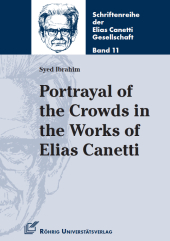 Neuerscheinungen 2016Stand: 2020-02-01 |
Schnellsuche
ISBN/Stichwort/Autor
|
Herderstraße 10
10625 Berlin
Tel.: 030 315 714 16
Fax 030 315 714 14
info@buchspektrum.de |

Syed Ibrahim
Portrayal of the Crowds in the Works of Elias Canetti
Dissertationsschrift
2016. 355 S. 210 mm
Verlag/Jahr: RÖHRIG 2016
ISBN: 3-86110-603-5 (3861106035)
Neue ISBN: 978-3-86110-603-6 (9783861106036)
Preis und Lieferzeit: Bitte klicken
Crowds have always played an undisputedly transforming role in societies around the world. From Crusades to the nationalistic crowds of Hitler, from the non-violent crowds of Mahatma Gandhi to the Arab Spring or the secular crowds joining together to form festive crowds in India or even the crowds as we experience them today in the virtual world of social networks, this phenomenon has fascinated and occupied the thoughts and imaginations of many thinkers, poets and sociologists. Elias Canetti, with his seminal work Crowds and Power stands out with his immensely rich and expansive study on crowds. This book analyses the crowds in Canetti´s works and makes a scholarly attempt to relate his crowd theories to the present-day world, especially to the crowds that have influenced us during the last twenty-five years across the world; with a particular reference to the crowds in India and those in today´s virtual world of Internet.
Acknowledgements
Foreword
Synopsis
1. Introduction
2. Elias Canetti and his Relationship with Crowds; 2.1. Canetti´s Life; 2.2. Works by Canetti; 2.3. Canetti´s encounters with Crowds; 2.3.1. The murder of Walther Rathenau und thedemonstrations in Frankfurt; 2.3.2. The Burning of the Viennese Court of Justice; 2.3.3. Captivity for 35 years and until death; 2.3.4. Being inside and outside of the crowd
3. Portrayal of the crowds in Canetti´s Masse und Macht; 3.1. Open and Closed Crowds (Offene und Geschlossene Massen); 3.1.1. Open Crowds (Offene Massen); 3.1.2. Geschlossene Massen (Closed Crowds); 3.2. Aspects of Crowds; 3.3. Classification of the crowds based on their Attributes; 3.4. Crowds of descendants; 3.5. Classification of the crowds based on Emotions; 3.5.1. The Hetzmasse (baiting crowd); 3.5.2. The Fluchtmasse (The flight or fleeing crowd); 3.5.3. The Verbotsmasse (Prohibition Crowds); 3.5.4. The Umkehrungsmasse (Reversal Crowds); 3.5.5. The Festmasse (Feast Crowds); 3.6. Canetti´s Theory of the Doppelmassen (The Double Crowds); 3.7. Crowd Crystals; 3.8. Crowd Symbols; 3.9. The "packs" and religions; 3.10. Crowds and religions; 3.11. Crowds in History; 3.11.1. Crowds & Command
4. Portrayal of the Crowds in the other major works of Elias Canetti; 4.1. Crowds in Die Blendung; 4.2. Portrayal of the crowds in Canetti´s plays; 4.2.1. Komödie der Eitelkeit (The Comedy of Vanity); 4.2.2. Hochzeit (The Wedding); 4.2.3. Die Befristeten (The Numbered); 4.3. Elements of Doppelmassen in Die Stimmen von Marrakesch; 4.4. Canetti´s Autobiographies; 4.4.1. Die gerettete Zunge (The Tongue Set Free); 4.4.2. Die Fackel im Ohr (The Torch in My Ear); 4.4.2. Das Augenspiel (Play of the Eyes)
5. Canetti´s Theories as Applied to the Crowds in the Present World; 5.1. The Multiple Crowd that United Germany; 5.2. The Y2K Crowd; 5.3. The 9/11 Crowd; 5.4. The lamenting Crowd - Death of Princess Diana; 5.5. The festive Crowd of Oktoberfest; 5.6. The Fluchtmasse: The anti-euro Crowd in Sweden; 5.7. The Verbotsmasse: The Crowd of Stuttgart 21; 5.8. The Umkehrungsmasse: The Occupy Wall Street Crowd; 5.9. The Umkehrungsmasse: The despairing Crowd in Greece; 5.10. The Umkehrungsmasse: The Crowd of Arab Spring; 5.11. The Festmasse: The festive Crowd of Times Square; 5.12. The ring Crowd in a German Football Stadium; 5.13. The Unsichtbare Masse: The Crowd in Space
6. Canetti´s Theories as applied to the Crowd Symbol and Crowds in Today´s India; 6.1. Fire as the unifying force; 6.2. Fire in Hinduism; 6.3. Canetti and Fire; 6.4. The Crowd Symbol of India; 6.5. Canetti and the Crowds in India; 6.5.1. India´s Freedom Struggle - Deformation of a non-violent Crowd; 6.5.2. The Crowd of Ganesh Chathurthi in Mumbai - A symbol of religious harmony; 6.5.3. Attukal Pongala - The feminine crowd; 6.5.4. The Cricket Crowd in India; 6.5.5. The Crowd at Sabarimala - A symbol of universal Faith; 6.5.6. The devout Crowd of human Gods
7. Canetti´s Theories as Applied to the Crowd in the Virtual World; 7.1. The State of Iran vs. Social Networks; 7.2. The Virtual Crowds and their Challenges Today
8. Conclusion; 8.1. Political, social and economic changes in the last two decades and their impact on crowd formation and disintegration; 8.2. Crowds in today´s India
Bibliography
Elias Canetti´s Biography


